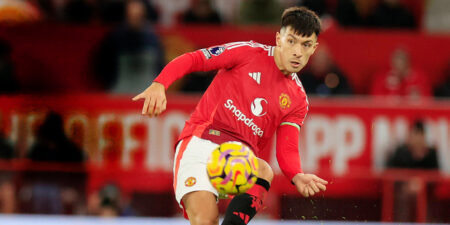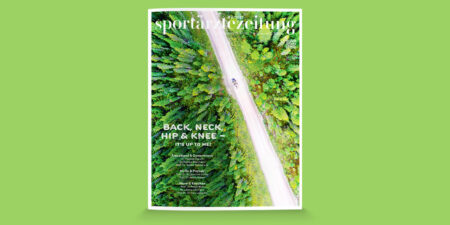In our daily orthopaedic practice we are repeatedly faced with acute patients who have activated osteoarthritis. In the light of today’s understanding of the side effects and late complications of corticosteroids, their formerly widespread use for activated osteoarthritis is precluded today, for this indication as well.
For this reason, modern regenerative therapy concepts are needed here that lead to quick and lasting relief of symptoms. This is why the combination of different procedures with synergistic effects has proved to be so effective in our daily practice over the past years. We use hyperbaric CO2 cryotherapy (Fig. 1), high-intensity laser therapy, extracorporeal magneto transduction therapy (EMTT), focused extracorporeal shock wave therapy (ESWT), and PRP/ hyaluronic acid injections depending on the constellation of findings.
Case 1: Acute activated osteoarthritis of the knee following osteonecrosis of the medial femoral condyle (Ahlback’s disease)
History
The active 64-year-old [female] patient, whom we had last treated at our practice in the spring of 2020, was already known to us. The patient has pronounced varus osteoarthritis that she developed a few years ago associated with Ahlback’s disease with considerable bone oedema at the time (Fig. 2). She reported that she had been symptom-free for almost two years since our last treatment, and that she could cope well with her everyday living including moderate sporting activities. Now she had once again been exposed to high physical demands while clearing the home of her aged mother, and this had reactivated her symptoms again. She had already had a follow-up MRI performed recently and asked us to quickly start a new course of treatment.
Clinical findings (at the first consultation 07/2022)
At the first consultation in July 2022 the patient rated her pain as 7 on a VAS, the right knee joint was giving her considerable pain on pressure in the region of the medial joint space and femoral condyle, the soft tissues here showed oedematous swelling with moderate effusion on clinical examination.
Imaging
The recent MRI of the right knee joint (06/2022) shows considerably activated varus osteoarthritis, now with increased bone oedema compared with the previous images, effusion associated with irritation, and a small Baker’s cyst.
Diagnosis
Right-sided varus osteoarthritis reactivated by overuse with a history of spontaneous osteonecrosis of the knee joint (Ahlback’s disease).
Procedure and course
First we gave her the following treatment combination 1 – 2x weekly for 4 weeks: to reduce the acute irritative state of the soft and synovial tissues: hyperbaric CO2 cryotherapy (Cryolight Elmako) and high-intensity laser therapy (BTL Highpowerlaser), pulsed using the acute programme to avoid generating heat in the tissues.
To reduce the newly activated bone oedema: extracorporeal magneto transduction therapy (EMTT) Magnetolith setting 8, 4 Hz, 4000 impulses. After only the first session with this treatment regimen we achieved pain reduction from 7 to 5 on the VAS, and this decreased relatively quickly to a VAS of 2 – 3 in the further course. The patient also reported very rapid regression of the peak pain on loading, while a significant reduction of the nocturnal pain at rest (which we associated with the pain of the bone oedema) was only noted after the 4th treatment. This matches the observation that we make with many patients treated with EMTT in which we need
3 – 4 treatment sessions to gain a significant reduction in pain. This is also one of the reasons why we work with at least two treatment sessions a week if possible. Once the patient was mobile enough to go for short hikes and ride her e-bike after this 4-week treatment series, we gave her another four treatments with the Magnetolith and cryotherapy to secure the treatment outcome and integrated her into individual medical training therapy for further dosed increased endurance for 2 – 3 months.
Case 2: Activated osteoarthritis of the shoulder and tendinosis of the rotator cuff
History
This [female] patient was a 72-year-old medical doctor who actively participates in equestrian and cycling sports. She said she thought she had injured her right rotator cuff after falling off a horse over 10 years before, and had had repeated episodes of symptoms in her shoulder ever since. Since the symptoms had not been so pronounced for surgery to be considered, she had not yet requested any imaging and had only had sporadic physiotherapy. However, the symptoms had been worsening over the last few months and by now she could no longer sleep through the night, she could no longer lie on her right side, and almost all movements were limited by pain.
Clinical findings (At the time of her first appointment)
At the clinical examination she reported her current pain to be 7 on a VAS. Her movements, both passive and active, were considerably restricted. Placing her hand behind her neck was about 10 cm less on the right compared with the left, placing her hand between her shoulder blades from below was barely possible on the right, and movements of the scapula were considerably limited. Examination of the surrounding musculature showed active trigger points, above all in the subscapularis, trapezius and infraspinatus muscles.
Imaging
Ultrasonography showed pronounced intra-articular effusion extending along the long head of the biceps tendon, the supraspinatus tendon showed degenerative changes and thinning, and there were also pronounced arthritic changes. The MRI requested after this showed advanced activated osteoarthritis of the shoulder, articular effusion, degenerative changes in the supraspinatus and subscapularis tendons compatible with tendinosis and fraying, but no transmural rupture.
Diagnosis
Activated osteoarthritis of the shoulder with articular effusion, rotator cuff tendinosis, restricted scapular movement and active trigger points (subscapularis and infraspinatus muscles).
Procedure and course
The following therapeutic procedures were started due to the first clinical and sonographic findings (only once weekly due to the 2-hour car journey here): low energy focused pericapsular shockwave therapy, treatment of the named trigger points by focused ESWT and dry needling, hyperbaric CO2 cryotherapy, EMTT Magnetolith 8/4/4000, kinesio taping and osteopathic treatment. This treatment regimen alone was able to reduce pain peaks substantially, and transient pain relief to VAS 2 – 3 was achieved directly after the treatments. During the 3rd and 6th treatment sessions the procedure was augmented with an i.a. injection of PRP and hyaluronic acid (CellularMatrix Regen Lab). The patient reacted to the first injection with considerable initial aggravation (VAS 6) for 2 – 3 days, followed by a slow, continuous improvement to a VAS of 2 – 3. After the 2nd PRP injection she again complained of initial worsening to VAS 3 – 4 for 3 days followed by further pronounced pain reduction to VAS 1 – 2. We continued the first-named treatments with cryo, ESWT and EMTT for some time at slightly longer intervals of 2 – 4 weeks and concluded treatment with a hyaluronic acid injection.
Summary
While the evidence for the individual regenerative procedures described above has become pretty good over the last few years, apart from a few isolated studies there are as yet few scientific data on their combination, or any more precise understanding of how the individual signal pathways influence each other. However, as I understand the various modes of action, and on the basis of the holistic regenerative treatment approach practiced at our orthopaedic-osteopathic practice, the combination has always appeared logical and has been proven in daily practice. The combination is matched to the respective clinical picture and the predominating individual tissue structures for the pain symptoms. If the inflammatory irritation of the soft tissues and the synovia is more prominent we consider high-intensity laser (pulsed to generate as little heat as possible) to be most appropriate. If the bony stress reaction in the form of bone oedema predominates, EMTT is our treatment of choice. In our opinion, hyperbaric CO2 cryotherapy and focused shockwave therapy of the articular capsule and the periarticular fascia insertions as well as any relevant trigger points are an important foundation for practically every treatment of osteoarthritis. For intra-articular pathologies we favour the combination of PRP and hyaluronic acid.
Our experience shows first that an intensive treatment block, initially with treatment twice a week to begin with, is beneficial, and second that cryo- and laser treatment of the soft tissues often brings rapid pain relief while EMTT for the treatment of bony stress reaction often needs 3 – 4 treatments to achieve significant reduction in pain. Furthermore, in our view it is often very important to treat the surrounding myofascial structures and the muscles in the entire chain. Overall, the combination of various regenerative procedures with synergistic effects has proved to be most effective for the treatment of activated osteoarthritis in our daily practice. By these means we achieve rapid and long-lasting pain relief for the patient even without using corticosteroids and, apart from the risk of occasional initial aggravation for 1 – 3 days, they have an excellent side-effect and risk profile.
Autoren
ist Facharzt für Orthopädie und Unfallchirurgie, Diplom Osteopath. Er ist Gründer der Privatpraxis für Orthopädie und Osteopathie in Freiburg und seit Jahren aktiv im Bereich der regenerativen Medizin (ESWT, PRP, Stammzelltherapie, Prolotherapie; Pain School International Budapest).






